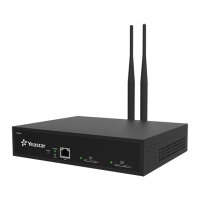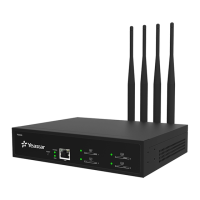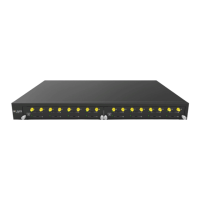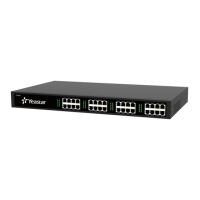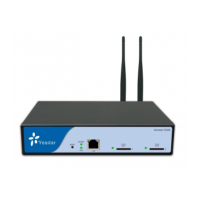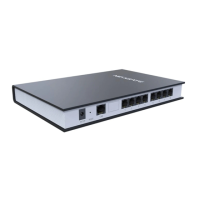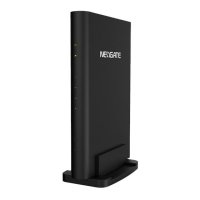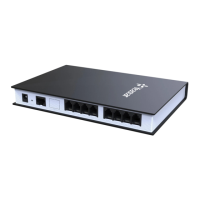Do you have a question about the Yeastar Technology NeoGate TG400 and is the answer not in the manual?
| Product Type | GSM Gateway |
|---|---|
| GSM Channels | 4 |
| Frequency | 850/900/1800/1900 MHz |
| Protocols | SIP, IAX2 |
| SMS Support | Yes |
| Multiple Language Support | Yes |
| Web GUI | Yes |
| Power Supply | AC 100-240V, 50/60Hz |
| Certifications | CE, FCC, RoHS |
| Voice Codec | G.711, G.723, G.729 |
| Network Interface | 10/100 Mbps Ethernet |
| Transport Protocols | TCP, UDP |
| Network Protocols | HTTP, HTTPS, TFTP, DHCP |
| Operating Temperature | 0°C to 40°C |
| Storage Range | -20°C to 70°C |
| Operating Humidity | 10% to 90% non-condensing |
| Humidity | 10% to 90% non-condensing |
Lists the key features of the NeoGate TG Gateway, including SIP proxy, call routing, SMS, USSD, and more.
Details the hardware specifications of the NeoGate TG series, including models and channels.
Instructions on how to insert and remove the SIM card, including notes on SIM type and power safety.
Guidance on connecting the external antenna for optimal wireless signal reception.
Explains how to connect the NeoGate TG to a network using Ethernet ports and LEDs.
Details the power supply requirements and connection steps for the NeoGate TG unit.
Allows checking the system's operational status, including trunk, network, and system information.
Displays the status of GSM/UTMTS/CDMA and VoIP trunks, including signal and registration details.
Shows the IP address and status of the LAN port and other network configurations.
Provides information about the hardware/firmware version and disk usage of the NeoGate TG.
Captures detailed call information, allowing administrators to search and filter call data.
Allows downloading and deleting system logs for debugging purposes.
Enables configuration of network settings, including LAN, VLAN, VPN, and DDNS.
Configures basic LAN settings like IP address, subnet mask, gateway, and DNS.
Allows configuration of Virtual LANs (VLANs) for network segmentation and management.
Supports OpenVPN configuration for secure remote network connections.
Configures Dynamic DNS settings to maintain an accessible hostname for dynamic IP addresses.
Allows setting static routes for specific network traffic to use different gateways.
Provides access to various security configurations like Firewall, Services, and Ports.
Configures system alerts via call or email for security events like IP attacks and web logins.
Allows uploading certificates for TLS trunk functionality.
Manages firewall rules for general settings, common rules, and auto-defense.
Configures IP blacklist rules based on packet rate to automatically block suspicious IP addresses.
Allows changing the default administrator password for enhanced security.
Configures the system's date, time, and time zone, with options for NTP synchronization.
Enables uploading and downloading custom voice prompts for system use.
Configures email settings for sending system alerts and voicemail notifications.
Guides on upgrading the device firmware using TFTP or HTTP URL.
Allows backing up and restoring system configurations and custom prompts.
Provides options to reboot the system or reset it to factory defaults.
Enables sending SMS messages directly via GSM/UTMTS/CDMA ports.
Allows managing contacts for sending SMS messages, organized by name or group.
Displays sent SMS messages with status and filtering options.
Shows incoming SMS messages with search and reply capabilities.
Explains the use of Unstructured Supplementary Service Data (USSD) for interacting with service providers.
Configures API settings to allow third-party software to send/receive SMS without the web interface.
Lists all GSM/UTMTS/CDMA modules and allows editing their settings, power, and reboot status.
Provides detailed configuration options for each GSM/UTMTS/CDMA channel, including general and call duration settings.
Allows creating and managing groups of GSM/UTMTS/CDMA channels for routing calls.
Configures call waiting functionality, allowing users to handle second incoming calls.
Sets up the 'Follow me' feature to redirect incoming calls to another number.
Allows creating and configuring VoIP accounts, trunks, and service provider trunks.
Enables creating trunk groups to route calls from GSM/UTMTS/CDMA to VoIP trunks.
Configures general SIP settings, NAT, codecs, QoS, response codes, and advanced options.
Configures settings for the IAX protocol, including bind port, bandwidth, and codecs.
Sets general preferences for VoIP, like ring timeout and MAX call duration.
Defines how calls from GSM/UTMTS/CDMA channels are routed to the IPPBX.
Defines how calls from the IPPBX are routed to GSM/UTMTS/CDMA channels.
Blocks incoming or outgoing calls by adding numbers to the blacklist.
Configures the callback feature, allowing users to initiate calls after hanging up.
Illustrates a basic application scenario connecting SIP phones and regular phones via the NeoGate TG.
Shows a more complex application scenario involving IPPBX, softphones, and regular phones.
